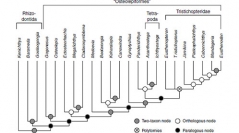

 Geodiversitas
26 (3) - Pages 381-389
Geodiversitas
26 (3) - Pages 381-389Previous attempts to quantify the adequacy between phylogenetic trees (cladograms with a temporal dimension) and the fossil record failed because of inappropriate statistics. A general explanation for this failure is based on a hierarchical perception of the temporal scale. When time is conceived as a hierarchy and not as an arrow, it can be expressed by a pectinate-shaped tree. Comparison between cladograms, based on morphological or molecular data, and time represented by a pectinate tree leads to the discovery of temporal paralogy, a phenomenon analogous to molecular, morphological, and biogeographical paralogies and already shown in these fields to bear severe difficulties.
Palaeontology, cladistics, temporal paralogy, quality of the fossil record